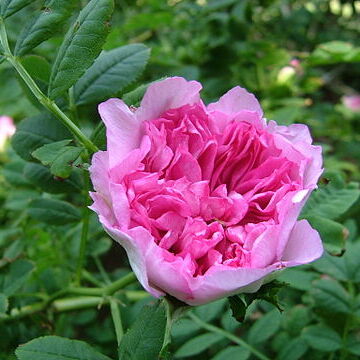Shrubs diffuse, 1–2.5 m tall. Bark gray-brown; branchlets ascending-spreading, purple-brown, terete; prickles paired at nodes, mostly straight, to 5 mm, somewhat flat, abruptly narrowing to broad base. Leaves including petiole 5–11 cm; stipules mostly adnate to petiole, free parts subulate, margin glandular-pubescent; rachis and petioles with scattered small prickles; leaflets 9–15, elliptic or oblong, rarely obovate, 1–2 × 0.6–1.2 cm, glabrous, abaxially with prominent veins, conspicuously reticulate, base broadly cuneate, margin acutely simply serrulate, apex acute or rounded-obtuse. Flowers solitary, or 2 or 3 and fasciculate apically on branches, 4–6 cm in diam.; pedicel short; bracts 2 or 3, small, margin glandular-pubescent. Hypanthium depressed-globose, densely bristly. Sepals 5, usually broadly ovate, abaxially densely prickly, adaxially tomentose, pinnately lobed, apex acuminate. Petals 5, slightly fragrant, pink to rose-purple or reddish, obovate. Carpels on projected torus at base of hypanthium; styles free, not exserted, shorter than stamens, pubescent. Hip green-red, depressed-globose, 1.5–2 cm in diam., densely prickly, with persistent, erect sepals. Fl. Mar–Jul, fr. Aug–Oct.
More
A stiff shrub. It grows 2 m high and spreads 2 m wide. It loses its leaves during the year. The branches are angular. The bark becomes flaky and peels off. The leaves have 15 small, light green leaflets. It has double pink flowers. These are darker towards the centre. The rose hips have spines.
Can be grown by cuttings, graftings or seedlings. Seeds needs scarification.

